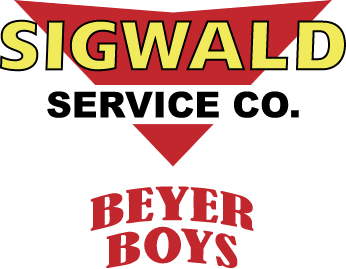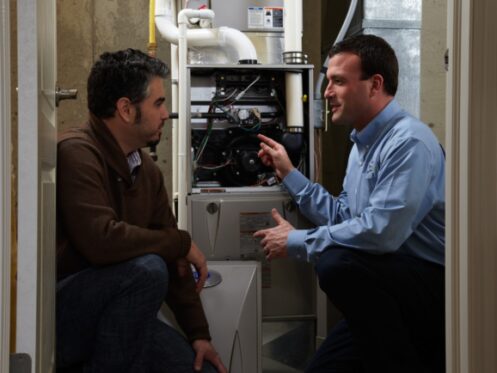A cracked heat exchanger is by far the most serious of all furnace issues. Not only will this issue limit how much heat the furnace produces, but it could also lead to a potentially deadly carbon monoxide leak. Heat exchangers will typically last for somewhere between 10 and 20 years, and a cracked heat exchanger is one of the main reasons that older furnaces fail and need to be replaced. Today, we’re going to provide a full overview of this issue, including what can cause a heat exchanger to crack, what issues it can cause, and the signs that can help you know if your heat exchanger is cracked.
How Does a Furnace Heat Exchanger Work?
Before we get into the issues that can cause a heat exchanger to crack, it is first necessary to understand a bit more about what the heat exchanger is and how it works. A heat exchanger is a series of metal tubes that run from the furnace’s combustion chamber to the exhaust flue or chimney. The heat exchanger is welded so that it creates an airtight seal with both the combustion chamber and exhaust flue to ensure that no fumes can escape.
Furnaces work by burning gas to produce hot combustion fumes. These fumes travel from the combustion chamber through the heat exchanger and are eventually vented outside through the exhaust flue. When the furnace is running, the fumes cause the metal heat exchanger to become extremely hot. In order to produce heat, the HVAC blower draws cold air into the furnace and forces it over the heat exchanger. This results in the heat energy being transferred from the heat exchanger into the air, and the blower then circulates this hot air through the ductwork and blows it out of all of your vents.
Causes of a Cracked Heat Exchanger
The main reason that a heat exchanger will crack is due to metal fatigue caused by normal wear and tear and aging. When the furnace is running, the metal always expands slightly as it heats up. Once the furnace shuts off, the heat exchanger begins to cool, and the metal then contracts again. This constant contraction and expansion slowly weakens the metal to the point where it can begin to crack, and this is why a heat exchanger will always fail eventually.
While a heat exchanger will normally last for at least 10 years, there are some issues that can lead to it cracking and failing much sooner. Overheating is one such issue as it will cause the metal to get much hotter and experience more expansion than normal. A furnace can overheat for a variety of reasons, but the most common cause is a clogged air filter that prevents sufficient cool air from being drawn into the furnace and over the heat exchanger. Overheating can also occur because the furnace is too large, or the ductwork and/or HVAC system wasn’t designed or installed correctly.
The heat exchanger can also easily get damaged if the furnace’s gas burners are dirty and clogged. Clogged burners will often result in the gas flowing into the furnace not lighting immediately. This delay allows the gas to start to fill the combustion chamber and can result in a small explosion or fireball once the gas does finally light, which can sometimes produce enough force to damage the heat exchanger.
Why a Cracked Heat Exchanger Is Such a Serious Issue
All gas furnaces have something known as a draft inducer, which is essentially a small fan that creates a draft so that the combustion fumes are drawn out of the combustion chamber through the heat exchanger and into the exhaust flue. In order to create this draft, the heat exchanger needs to have an airtight seal. If the exchanger is cracked, the inducer won’t be able to produce as much of a draft.
Without an adequate draft, some of the combustion fumes will remain trapped inside the combustion chamber instead of being drawn up through the heat exchanger. These combustion fumes are non-flammable and will starve the burner flames of oxygen, and this results in the gas not fully combusting.
When natural gas combusts fully, no carbon monoxide is produced. However, some carbon monoxide will always be produced if the gas doesn’t fully combust. If the heat exchanger is cracked and doesn’t have an airtight seal, the carbon monoxide can then escape through the cracks and enter your ductwork where it will then be circulated throughout the building by the blower. This is why a cracked heat exchanger is such a serious issue.
How to Spot the Signs of a Cracked Heat Exchanger
You should always have a carbon monoxide detector located around 15 feet away from your furnace just to be safe. However, relying on a carbon monoxide detector alone isn’t sufficient to ensure that your heat exchanger is still in good shape. This is because a cracked heat exchanger doesn’t always lead to incomplete combustion and thus causes the furnace to produce carbon monoxide.
That being said, carbon monoxide isn’t the only worry as some of the other normal combustion fumes are also toxic. This is why you should always have your furnace professionally inspected every year since it is the only real way to know if your heat exchanger is cracked or still in good shape. Unfortunately, inspecting the heat exchanger isn’t something you can do on your own as much of it is hidden away and not easily visible.
In the past, the only real options for inspecting a heat exchanger were to use a flashlight and mirrors or to dismantle the furnace. However, now most technicians use special infrared technology that makes it easy to spot even the smallest cracks.
While an inspection is the only guaranteed way to know if your heat exchanger is in good condition, there are a few other signs that can indicate your heat exchanger is cracked. For instance, a cracked heat exchanger will sometimes produce a loud rattling noise whenever the furnace is running. Chemical odors coming from the furnace or blowing out of your vents can also indicate a cracked heat exchanger as some of the combustion fumes have a strong smell similar to formaldehyde.
If you do suspect that your heat exchanger is cracked, it is essential that you turn your furnace off until you can have it inspected due to the risk of carbon monoxide poisoning. If the inspection determines that your heat exchanger is cracked, you will usually want to replace your entire furnace unless it is still under warranty. This is because the process of replacing a heat exchanger is quite difficult and time-consuming. As such, it will usually end up costing about the same as buying a new furnace.
Expert HVAC Services in Rockport
At Sigwald Service Co., we specialize in furnace inspections as well as all types of heating and cooling repairs in the Rockport area. Whether you’re dealing with a cracked heat exchanger or any other furnace or AC issue, we’re ready to help and provide the professional, reliable service you need. Our team also specializes in heating and cooling maintenance and installation as well as appliance repairs. For more information or to schedule a service appointment, contact us today.






